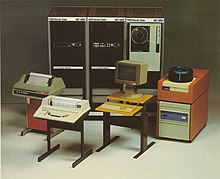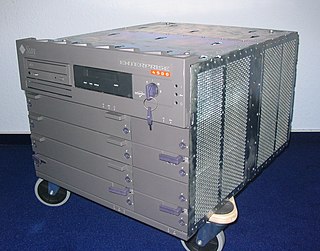
The ND-500 was a 32-bit superminicomputer delivered in 1981 by Norsk Data. It relied on a ND-100 to do housekeeping tasks and run the OS, SINTRAN III. A configuration could feature up to four ND-500 CPUs in a shared-memory configuration.

The ND-500 was a 32-bit superminicomputer delivered in 1981 by Norsk Data. It relied on a ND-100 to do housekeeping tasks and run the OS, SINTRAN III. A configuration could feature up to four ND-500 CPUs in a shared-memory configuration.
The ND-500 architecture lived through four distinct implementations. Each implementation was sold under a variety of different model numbers.
ND also sold multiprocessor configurations, naming them ND-580/n and an ND-590n, where n represented the number of CPUs in a given configuration, 2, 3, or 4.
Sold as the ND-500, ND-520, ND-540, and ND-560.
Sold as the ND-570, ND-570/CX, and ND-570/ACX.
A 28-bit version of the ND-500 machine. Pins were snipped on the backplane, removing its status as a superminicomputer, allowing it to legally pass through the CoCom embargo.
Sold as the ND-5200, ND-5400, ND-5500, ND-5700, and ND-5800. The ND-120 CPU line, which constituted the ND-100 side of most ND-5000 computers, was named Delilah. As the 5000 line progressed in speed, the dual-arch ND-100/500 configuration increasingly became bottlenecked by all input/output (I/O) having to go through the ND-100.
Sold as the ND-5830 and ND-5850. The Rallar processor consisted of two main VLSI gate arrays, KUSK (En: Jockey) and GAMP (En: Horse).
LED was a programmer's source-code editor by Norsk Data running on the ND-500 computers running Sintran III. It featured automatic indenting, pretty-printing of source code, and integration with the compiler environment. It was sold as an advanced alternative to PED. Several copies exist, and it is installed on the NODAF public access ND-5700.
In 1982–83, Logica PLC in London undertook a project, on behalf of ND, to port Unix Berkley Software Distribution (BSD) 4.2 to the ND-500. A C compiler from Luleå University College in Northern Sweden was used. The goal was to port Unix BSD to the ND-500 and use the ND-100 running Sintran-III as the front end. Thus, all I/O had to go through the ND-100 which proved very inefficient. For example, running vi on the ND-500 brought the ND-100 to its knees. The purpose of the effort was so that ND could sell the 500 to the European Organization for Nuclear Research (CERN), who were buying VAXes from Digital Equipment Corporation. But the ND-500 was unable to meet CERN's goals. Although the ND-500 processor was very fast for its time, it couldn't compete with the superior VAX I/O architecture.

An operating system (OS) is system software that manages computer hardware and software resources, and provides common services for computer programs.

The PDP-11 is a series of 16-bit minicomputers sold by Digital Equipment Corporation (DEC) from 1970 into the late 1990s, one of a set of products in the Programmed Data Processor (PDP) series. In total, around 600,000 PDP-11s of all models were sold, making it one of DEC's most successful product lines. The PDP-11 is considered by some experts to be the most popular minicomputer.

VAX is a series of computers featuring a 32-bit instruction set architecture (ISA) and virtual memory that was developed and sold by Digital Equipment Corporation (DEC) in the late 20th century. The VAX-11/780, introduced October 25, 1977, was the first of a range of popular and influential computers implementing the VAX ISA. The VAX family was a huge success for DEC – over 100 models were introduced over the lifetime of the design, with the last members arriving in the early 1990s. The VAX was succeeded by the DEC Alpha, which included several features from VAX machines to make porting from the VAX easier.
The 88000 is a RISC instruction set architecture developed by Motorola during the 1980s. The MC88100 arrived on the market in 1988, some two years after the competing SPARC and MIPS. Due to the late start and extensive delays releasing the second-generation MC88110, the m88k achieved very limited success outside of the MVME platform and embedded controller environments. When Motorola joined the AIM alliance in 1991 to develop the PowerPC, further development of the 88000 ended.

Computer operating systems (OSes) provide a set of functions needed and used by most application programs on a computer, and the links needed to control and synchronize computer hardware. On the first computers, with no operating system, every program needed the full hardware specification to run correctly and perform standard tasks, and its own drivers for peripheral devices like printers and punched paper card readers. The growing complexity of hardware and application programs eventually made operating systems a necessity for everyday use.

Convex Computer Corporation was a company that developed, manufactured and marketed vector minisupercomputers and supercomputers for small-to-medium-sized businesses. Their later Exemplar series of parallel computing machines were based on the Hewlett-Packard (HP) PA-RISC microprocessors, and in 1995, HP bought the company. Exemplar machines were offered for sale by HP for some time, and Exemplar technology was used in HP's V-Class machines.

Norsk Data was a minicomputer manufacturer located in Oslo, Norway. Existing from 1967 to 1998, it had its most active period from the early 1970s to the late 1980s. At the company's peak in 1987, it was the second largest company in Norway and employed over 4,500 people.
The Burroughs Large Systems Group produced a family of large 48-bit mainframes using stack machine instruction sets with dense syllables. The first machine in the family was the B5000 in 1961. It was optimized for compiling ALGOL 60 programs extremely well, using single-pass compilers. It evolved into the B5500. Subsequent major redesigns include the B6500/B6700 line and its successors, as well as the separate B8500 line.

Sun Enterprise is a range of UNIX server computers produced by Sun Microsystems from 1996 to 2001. The line was launched as the Sun Ultra Enterprise series; the Ultra prefix was dropped around 1998. These systems are based on the 64-bit UltraSPARC microprocessor architecture and related to the contemporary Ultra series of computer workstations. Like the Ultra series, they run Solaris. Various models, from single-processor entry-level servers to large high-end multiprocessor servers were produced. The Enterprise brand was phased out in favor of the Sun Fire model line from 2001 onwards.

The DECstation was a brand of computers used by DEC, and refers to three distinct lines of computer systems—the first released in 1978 as a word processing system, and the latter two both released in 1989. These comprised a range of computer workstations based on the MIPS architecture and a range of PC compatibles. The MIPS-based workstations ran ULTRIX, a DEC-proprietary version of UNIX, and early releases of OSF/1.

Unix System V is one of the first commercial versions of the Unix operating system. It was originally developed by AT&T and first released in 1983. Four major versions of System V were released, numbered 1, 2, 3, and 4. System V Release 4 (SVR4) was commercially the most successful version, being the result of an effort, marketed as Unix System Unification, which solicited the collaboration of the major Unix vendors. It was the source of several common commercial Unix features. System V is sometimes abbreviated to SysV.
Mach-O, short for Mach object file format, is a file format for executables, object code, shared libraries, dynamically-loaded code, and core dumps. It was developed to replace the a.out format.

The O2 was an entry-level Unix workstation introduced in 1996 by Silicon Graphics, Inc. (SGI) to replace their earlier Indy series. Like the Indy, the O2 used a single MIPS microprocessor and was intended to be used mainly for multimedia. Its larger counterpart was the SGI Octane. The O2 was SGI's last attempt at a low-end workstation.

Nord-10 was a medium-sized general-purpose 16-bit minicomputer designed for multilingual time-sharing applications and for real-time multi-program systems, produced by Norsk Data. It was introduced in 1973. The later follow up model, Nord-10/S, introduced in 1975, introduced CPU cache, paging, and other miscellaneous improvements.
The Nord-100 was a 16-bit minicomputer series made by Norsk Data, introduced in 1979. It shipped with the Sintran III operating system, and the architecture was based on, and backward compatible with, the Nord-10 line.
The Orion was a series of 32-bit super-minicomputers designed and produced in the 1980s by High Level Hardware Limited (HLH), a company based in Oxford, UK. The company produced four versions of the machine:

The Sun-2 series of UNIX workstations and servers was launched by Sun Microsystems in November 1983. As the name suggests, the Sun-2 represented the second generation of Sun systems, superseding the original Sun-1 series. The Sun-2 series used a 10 MHz Motorola 68010 microprocessor with a proprietary Sun-2 Memory Management Unit (MMU), which enabled it to be the first Sun architecture to run a full virtual memory UNIX implementation, SunOS 1.0, based on 4.1BSD. Early Sun-2 models were based on the Intel Multibus architecture, with later models using VMEbus, which continued to be used in the successor Sun-3 and Sun-4 families.

Norsk Data (ND) was a Norwegian manufacturer of minicomputers which operated between 1967 and 1992. The company was established as A/S Nordata – Norsk Data-Elektronikk on 7 July 1967 and took into use the Norsk Data brand in 1975. The company was founded by Lars Monrad-Krohn, Rolf Skår and Per Bjørge, three computer engineers working at the Norwegian Defence Research Establishment which had just built the minicomputer SAM 2. ND's first contract was the delivery of a Nord-1 computer to Norcontrol. Initially in competition with Kongsberg, ND started delivering computers to Norwegian institutions. By 1972 the company had developed Sintran operating system, the 32-bit Nord-5 and a time sharing system.
The PowerNode 9080 was a dual processor 32-bit Superminicomputer produced by Fort Lauderdale, Florida based electronics company Gould Electronics in the 1980s. Its UTX/32 4.3BSD Berkeley Unix-based operating system was one of the first multi-processor shared memory implementations of Unix, although the processors operated in a Master-Slave configuration with a Mutual Exclusion (MutEx) lock on all manipulations on Kernel tables. The second processor, called IPU, left all I/O operations to the main CPU. Machines could be configured for either single or dual processor operation.